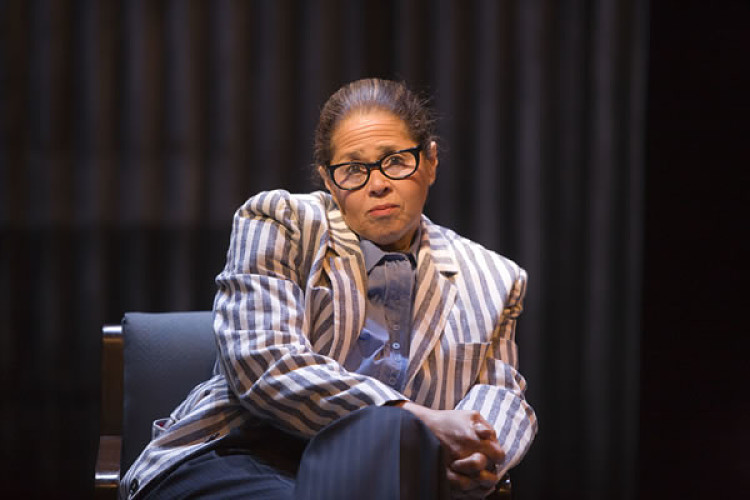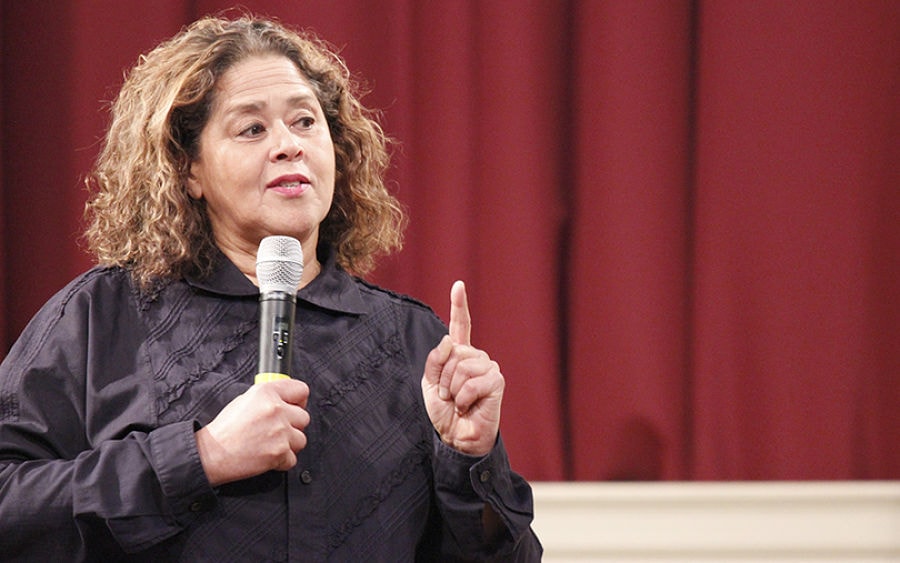WASHINGTON, D.C.: “They say it better than I do,” is how Anna Deavere Smith explained her approach to lecturing, but she could just as well be describing the theatrical aesthetic with which she’s woven together the voices of hundreds of Americans into as many as 18 so-called “verbatim theatre” plays, from Twilight: Los Angeles 1992 to House/Arrest to Let Me Down Easy, in an ongoing project she calls “On the Road: A Search for American Character.”
That’s also the title of the talk the playwright/performer will give tonight, April 6, when she delivers the National Endowment for the Humanities’ Jefferson Lecture in the Humanities at Washington, D.C.’s Kennedy Center (watch a livestream here starting 7:30 p.m. EST). She’ll begin the program in the guise of the late author/gadfly Studs Terkel, speaking in his folksy urban drawl about the importance of questioning official truth. She’ll also segue into characters from some of the shows she’s created around flashpoint American issues, and preview sections of her next work-in-progress, a “school-to-prison pipeline project” tentatively titled “Notes From the Field: Doing Time in Education.” The project, for which Smith interviewed hundreds of students, parents, teachers, prison personnel and others in California, will next do field work in Baltimore (Smith’s hometown), Philadelphia and an unspecified “Southern area,” to be followed a production some time in the 2016–17 theatre season.
She spoke to American Theatre last week about her plans for the lecture, how her work has developed over the years, and why, for all the heavy material she deals with in her work, she’s hopeful about the potential for change through the intimate exchange of theatre.
AMERICAN THEATRE: Can you tell me about the form of the speech—will you be going back and forth between you talking and your characters talking?
ANNA DEAVERE SMITH: Part of my career since the ’90s has been as a lecturer, so that’s a form I’ve kind of developed. I’ll also be presenting portayals of people who have ideas that are better than mine, and who help me by their presence, by their artful articulation—they say it better than I do, so I present them. If I were a photographer, I would talk and show slides, or if I were Wynton Marsalis, I don’t think I’d be talking the whole time.
So will it be a sort of “greatest hits” anthology from previous shows?
No. I have some themes that I want to get at, at the center of which is the American quest for a more perfect union. That’s why people come here—now, my race was brought here against our will, and Native Americans were already were here. But that’s the promise: that you can matter here in a way you didn’t elsewhere. Sometimes people feel that way about this country, and sometimes they don’t. My plays have tended to focus on the moments when it was kinda rocky, but there are still people who are doing their best to try to believe in it again. That’s really the organizing principle, and that’s how I chose the people I will present.

Another theme is best encapsulated by Martin Luther King Jr.’s “Letter from a Birmingham Jail,” where he wrote, “We are caught in an inescapable network of mutuality, tied in a single garment of destiny.” It’s always useful for some of us, in our art or our public speaking, whatever we do, to use whatever platform we have to announce that, to remind people of that.
The lecture is named for Thomas Jefferson. Do you take inspiration from him, or does that just happen to be the name of the lecture?
It will be very interesting to find out why the lecture was named after Jefferson. I did perform Jefferson in House/Arrest, and I tried to get close to him, even as there are things about him that are controversial, particularly for me as an African-American woman. I did feel very interested in him, in part because my search for the American character has been a lot about what is not me, and Jefferson would have to be pretty far on the extreme spectrum away from me. But my visit to Monticello is one I will always remember, and there are many things to admire about Jefferson. He was a kind of paradox; he created some of our problems, but he also gave us the keys to get out of them. I think Jefferson would be proud of the America that has come forward.
Tell me about the “school to prison pipeline” project. It’s not a phrase I’d heard before.
I did not make up the phrase; I believe some have attributed it to Marian Wright Edelman. It has come to be known as a way of expressing the problem of kids who are suspended or expelled for things that may seem to be not as grave as suspension or expulsion might seem to indicate. Some of these had their origin in the perfectly understandable no-tolerance policies that came in after Columbine, but the people who suffer most from this are poor kids, black, brown and Native American kids. A certain number of these suspensions lead to incarceration, and incarceration doesn’t just tear these kids away from their lives but also from their whole communities. I’ve heard some say that education will be the ground for new Civil Right movement. I don’t know if that’s true, but as I tend to be interested in places where there’s injustice, I’m going to go there.
Wasn’t education also a battleground in the first Civil Rights movement?
When we look back after 60-plus years of Brown v. Board of Education, some say we’re more segregated now than we were then. And look, education is a quandary not just for poor kids. If you talk to the mother of a kid on the Upper West Side, she’ll be tearing her hair out, ready to sell a leg to get her kid into a school. There’s a lot of pressure, and it’s not ideal for anybody. I’m not sure why we’re at this place where what LBJ called our fifth freedom, the freedom from ignorance, is in such trouble. But they always say, when white folks get a cold, black folks get pneumonia.
And we’re at a place where the very nature of human cognition may be changing, or the people in Silicon Valley seem to think so. Are our computers smarter than us? So everything is changing. So under the pressure of all that, it’s really the seeds for a storm: Our schools are in trouble and we’ve got the highest incarceration rate in the world. It seems now that both Democrats and Republicans agree that it’s too expensive and we’ve got to find another way.
Have you tried out new performance work in your lectures before?
No. This is a work in progress, and it’s different from other works I’ve done. It’s because I’m rethinking the model of how work is created in the American theatre, where you go off and work on something in private and then you bring it out when it’s ready. I’ve decided I’m bringing this out when it’s not ready. My single goal is to create conversation—I hope I sell some tickets somewhere along the line, but what I want to do is create conversation, and that’s is why I’m doing this differently.
Are you frustrated that theatre isn’t as much at the center of our national conversation as other media are—is that one reason you want to break the form a little?
Well, that is stuff I started thinking about in the 1990s, and at Harvard I created the Center for the Arts and Civic Dialogue, what I called “a think and do tank.” People thought you couldn’t have both artistic excellence and relevance, but now you can’t go to a university arts program where students aren’t thinking about what their work can say. Just look at the Oscars; the speeches used to be just lists of people to thank, but this year five different people used that platform to say serious things about challenges we’re facing. So just by the numbers, we should be seeing a lot of extraordinary work coming out of these schools that’s artistically sound and full of the texture of life that we need, something that goes hand in hand with what politicians, human rights people want—people who’ve really got to move hearts and minds.
I’m not so disturbed by the sliver that theatre serves. I’ve always wanted it to be more diverse, and for there to be a more diverse administration and people who work in it as well as in the audience. I would like to see that. But I’m not worried so much about the local. Given social media, it’s with the local that audiences have the opportunity to share and engage. I’m okay with the intimacy of it.
I’ll ask people at my lectures: “How many of you know about me because of the theatre I’ve been making since 1973?” I’ll get small applause. Then I’ll say, “How many of you know me from The West Wing?” and I get a lot more applause–and I had a small part on The West Wing. But I’m all right with that.
I’ve always wondered about your process. When you’re interviewing someone, are you thinking, “Oh, that will be good, I’m definitely using that”?
I always am doing that. I have so much material—I did interviews on three continents. I do know when I’m there if it’s a moment I’ll want to use, and that informs who else I want to interview and the questions I want to ask. When I go back later, I start with: What do I remember? Then there’s this elaborate process.
Years ago, Oregon Shakespeare Festival was going to do a multicharacter staging of Twilight, but it fell through for some reason. Are the plays you created as a solo artist often done by ensembles?
More than people realize. I was quite moved by video I saw recently of young people at Princeton Country Day School doing Twilight. It’s important that kids like that—kids with privilege who are gonna make a difference—that they had a chance to embody somebody who got shot in the stomach while they were pregnant.
I think there has been a misunderstanding that my work was meant to be performed by only one woman. The way I started out with my first performance was with 20 real people I cast in a show. I staged it in SoHo in the 1970s. But I thought, “How will I ever have enough money to pay actors?” Then I remembered I had been a good mimic as a child, and I thought: I’ll just do it.


